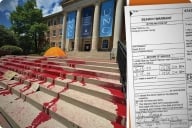You have /5 articles left.
Sign up for a free account or log in.
Despite an overall slowdown in the growth of international student applications, and a 3 percent drop in applications from the top sending country, China, initial offers of admission to international students for U.S. graduate schools increased 9 percent this year over last. This matches last year’s growth rate and represents the fourth straight year of growth in international admission offers, according to a survey released today by the Council of Graduate Schools, which has tracked trends in international graduate admissions and enrollments since 2004.
“Are we digging much deeper into the pool and thereby admitting less qualified students?” asked Debra W. Stewart, the Council’s president. "That's the obvious question but we don’t have any reason to think that’s true at this point. And the reason is because the pools from China and India are so very deep and very strong." At some point, she said, that could be a matter of concern, but at this point she said the main concern she has is the reversal of the trend-line regarding applications from China.
"There’s a reason to keep an eye on this, because China is a huge provider of high-quality graduate students to U.S. STEM [science, technology, engineering and mathematics] graduate programs. We have confirmed a clear decline of 3 percent after record, double-digit increases for three years and strong increases for several years before that.”
Percent Change in Chinese Student Applications to U.S. Graduate Schools
|
2009-10 |
2010-11 |
2011-12 |
2012-13 |
|
20 |
21 |
19 |
-3 |
Over all, final numbers for this year’s application cycle show that there was a 2 percent growth in the number of total international student applications, down from a 9 percent increase in 2012 and 11 percent in 2011. The 2 percent growth rate is comparable to a preliminary figure of 1 percent growth that the Council of Graduate Schools released in April.
Numbers of applications were down for five of the seven countries included in the survey: South Korea (-15 percent), Taiwan (-13 percent), Mexico (-8 percent), Canada (-5 percent) and, of course, China (-3 percent).
By contrast, driving the overall growth was a big increase in applications from India, up 22 percent. Applications from Brazil were also up 25 percent, albeit from a small base. (Students from Brazil make up only about 1 percent of international graduate students in the U.S.)
Data for initial offers of admission show a corresponding big increase for Indian students, up 27 percent after being flat the year before. Initial admission offers to Chinese students grew by 5 percent despite the drop in applications. The total number of initial admission offers to students from South Korea, the third-largest sending country, declined by 10 percent. Offers of admission for Brazilian students grew by 46 percent.
The chart below includes these and other figures: the Council expanded the list of countries for which it tracks data in 2012, which is why there are some blank spaces for earlier years.
Percent Change in Offers of Admission to International Students
|
|
Final Offers of Admission, 2009-10 |
Final Offers of Admission, 2010-11 |
Final Offers of Admission, 2011-12 |
Initial Offers of Admission, 2012-13 |
|
International Total |
3 |
9 |
9 |
9 |
|
By Country of Origin |
|
|
|
|
|
China |
15 |
21 |
20 |
5 |
|
India |
-5 |
2 |
0 |
27 |
|
South Korea |
-7 |
-2 |
0 |
-10 |
|
Taiwan |
-- |
-- |
-4 |
-3 |
|
Canada |
-- |
-- |
9 |
-1 |
|
Mexico |
-- |
-- |
6 |
0 |
|
Brazil |
-- |
-- |
6 |
46 |
|
By Region of Origin |
|
|
|
|
|
Africa |
-- |
-- |
10 |
7 |
|
Europe |
-- |
-- |
2 |
0 |
|
Middle East |
10 |
16 |
17 |
12 |
The numbers for students from India have historically fluctuated more than the numbers for China. Regarding the surge this year from India, "it will be very interesting to see in years to come whether this is a sustainable upward trend or not,” said Jeff Allum, the director of policy and research analysis at the Council of Graduate Schools and a co-author of the report. “I think that’s something to watch for as well as the decline in China, and in a couple years we’ll really know what is happening there.”
The council’s survey had a 57 percent response rate. Included among the respondents were 79 of the 100 graduate schools awarding the largest numbers of degrees to international students. The council expects to publish the findings from its next survey, on final offers of admission and international enrollments, this fall.








